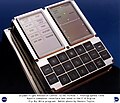קובץ:Apollo display and keyboard unit (DSKY) used on F-8 DFBW DVIDS683588.jpg

גודל התצוגה המקדימה הזאת: 765 × 600 פיקסלים. רזולוציות אחרות: 306 × 240 פיקסלים | 612 × 480 פיקסלים | 980 × 768 פיקסלים | 1,280 × 1,004 פיקסלים | 2,560 × 2,007 פיקסלים | 3,030 × 2,376 פיקסלים.
לקובץ המקורי (3,030 × 2,376 פיקסלים, גודל הקובץ: 6.18 מ"ב, סוג MIME: image/jpeg)
היסטוריית הקובץ
ניתן ללחוץ על תאריך/שעה כדי לראות את הקובץ כפי שנראה באותו זמן.
| תאריך/שעה | תמונה ממוזערת | ממדים | משתמש | הערה | |
|---|---|---|---|---|---|
| נוכחית | 09:29, 9 באוקטובר 2021 |  | 2,376 × 3,030 (6.18 מ"ב) | Huntster | Cropped 9 % vertically using CropTool with lossless mode. |
| 09:28, 9 באוקטובר 2021 |  | 2,606 × 3,030 (5.97 מ"ב) | Huntster | Full resolution from NASA. | |
| 03:42, 6 במאי 2015 |  | 1,321 × 1,536 (303 ק"ב) | Fæ | == {{int:filedesc}} == {{milim | description = {{en|1=The display and keyboard (DSKY) unit used on the F-8 Digital Fly-By-Wire (DFBW) aircraft during Phase I of the fly-by-wire program. Warning lights are in the upper left section, displays in the uppe... |
שימוש בקובץ
הדף הבא משתמש בקובץ הזה:
שימוש גלובלי בקובץ
אתרי הוויקי השונים הבאים משתמשים בקובץ זה:
- שימוש באתר ar.wikipedia.org
- שימוש באתר en.wikipedia.org
- שימוש באתר es.wikipedia.org
- שימוש באתר fi.wikipedia.org
- שימוש באתר fr.wikipedia.org
- שימוש באתר hu.wikipedia.org
- שימוש באתר ja.wikipedia.org
- שימוש באתר pl.wikipedia.org
- שימוש באתר ru.wikipedia.org
- שימוש באתר uk.wikipedia.org

